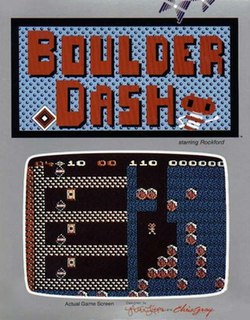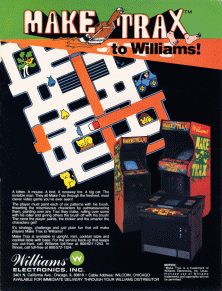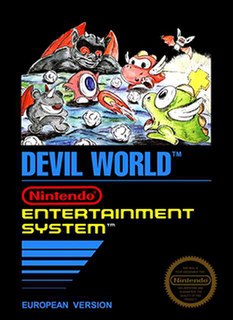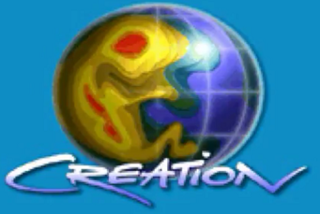Racing games are a video game genre in which the player participates in a racing competition. They may be based on anything from real-world racing leagues to fantastical settings. They are distributed along a spectrum between more realistic racing simulations and more fantastical arcade-style racing games. Kart racing games emerged in the 1990s as a popular sub-genre of the latter. Racing games may also fall under the category of sports video games.

An action game is a video game genre that emphasizes physical challenges, including hand–eye coordination and reaction-time. The genre includes a large variety of sub-genres, such as fighting games, beat 'em ups, shooter games, and platform games. Multiplayer online battle arena and some real-time strategy games are also considered action games.

Boulder Dash is a 2D maze-puzzle video game released in 1984 by First Star Software for Atari 8-bit computers. It was created by Canadian developers Peter Liepa and Chris Gray. The player controls Rockford, who collects treasures while evading hazards.

Crush Roller, released as Make Trax in North America, is a 1981 puzzle-maze game developed by Alpha Denshi and released for arcades by Kural Samno Electric in Japan. It was licensed in Europe to Exidy, who released it under its original title Crush Roller, and for North American release to Williams Electronics, who released it as Make Trax.

Mischief Makers, released in Japan as Yuke-Yuke!! Trouble Makers, is a side-scrolling platform game developed for the Nintendo 64 gaming console by Treasure, and published in 1997 by Enix in Japan and by Nintendo internationally. The player assumes the role of Marina Liteyears, a robotic maid who journeys to rescue her creator, Professor Theo, from the emperor of Planet Clancer. The gameplay is displayed in 2.5D, based on grabbing, shaking, and throwing objects within five worlds and 52 levels.

3D Monster Maze is a survival horror computer game developed from an idea by J.K. Greye and programmed by Malcolm Evans and released in 1981 for the Sinclair ZX81 platform with the 16 KB memory expansion. The game was initially released by J. K. Greye Software in December 1981 and re-released in 1982 by Evans' own startup, New Generation Software. Rendered using low-resolution character block "graphics", it was one of the first 3D games for a home computer, and one of the first games incorporating typical elements of the genre that would later be termed survival horror.

Rally-X is a maze chase arcade game developed and released by Namco in 1980. Players control a blue Formula One racecar through a series of multi-scrolling levels and must collect yellow flags scattered about. There are enemy red cars that pursue the player in an attempt to collide with them, and there are also boulders that must be avoided. Red cars can be temporarily stunned by laying down smoke screens at the cost of a portion of their fuel.

Snake Rattle 'n' Roll is a platform video game developed by Rare. It was published by Nintendo and released for the Nintendo Entertainment System in North America in July 1990 and in Europe on March 27, 1991. The game features two snakes, Rattle and Roll, as they make their way through eleven 3D isometric levels. A Mega Drive version was released by Sega in June 1993 with an extra level. Snake Rattle 'n' Roll was developed by Rare members Tim Stamper and Mark Betteridge. The music was composed by David Wise and was inspired by "Shake, Rattle and Roll" and other 1950s-era songs.

Devil World is a maze video game developed by Nintendo and Intelligent Systems and published by Nintendo for the Nintendo Entertainment System. It was released for the Famicom in Japan on October 5, 1984, and for the Nintendo Entertainment System in Europe on July 15, 1987. It was re-released on the Wii's Virtual Console in Japan on January 22, 2008, and in PAL regions on October 31, 2008. Due to Nintendo of America having policies over the use of religious icons in games, it was not released in North America. It is Shigeru Miyamoto's first console-only game after a legacy of arcade development, and his only game to not be localized to North America.

The Eidolon was one of two games that were part of Lucasfilm Games' second wave in December 1985. The other was Koronis Rift. Both took advantage of the fractal technology developed for Rescue on Fractalus!, further enhancing it. In The Eidolon, Rescue's fractal mountains were turned upside down and became the inside of a cave.

Frogger, also called Frogger: He's Back!, is an action video game remake and expansion of Konami's 1981 Frogger arcade game. It was developed by Sony Computer Entertainment's SCE Cambridge Studio and published by Hasbro Interactive in November 1997 for PlayStation and Windows. It has large maps, 3D graphics, and new gameplay moves. Critical reaction was mixed, with frequent criticism of the gameplay, controls, and difficulty, but the graphics were received positively. It was a commercial success, becoming one of the best-selling PlayStation games. Its box art was shared into the Genesis, SNES, Game.com, Game Boy, and Game Boy Color versions of the original Frogger.

Tutankham is a 1982 arcade video game developed and released by Konami and released by Stern in North America. Named after the Egyptian pharaoh Tutankhamun, the game combines a maze shoot 'em up with light puzzle-solving elements. It debuted at the European ATE and IMA amusement shows in January 1982, before releasing worldwide in Summer 1982. The game was a critical and commercial success and was ported to home systems by Parker Brothers.
In video games, first person is any graphical perspective rendered from the viewpoint of the player's character, or a viewpoint from the cockpit or front seat of a vehicle driven by the character. The most popular type of first-person video game today is the first-person shooter (FPS), in which the graphical perspective is an integral component of the gameplay. Many other genres incorporate first-person perspectives, including other types of shooter games, adventure games, amateur flight simulations, racing games, role-playing video games, and vehicle simulations.

Donkey Kong Country Returns is a 2010 side-scrolling platform game developed by Retro Studios and published by Nintendo for the Wii console. The game was released first in North America in November 2010, and in PAL regions and Japan the following month. The game's story focuses on an evil group of Tiki-like creatures known as the Tiki Tak Tribe that are unleashed on Donkey Kong Island and hypnotize the island's animals to stealing Donkey Kong and Diddy Kong's banana hoard, prompting the two to traverse the island to reclaim it.
Dungeons & Dragons retro-clones are fantasy role-playing games that emulate earlier editions of Dungeons & Dragons (D&D) no longer supported by Wizards of the Coast. They are made possible by the release of later editions' rules in a System Reference Document under the terms of the Open Game License, which allow the use of much of the proprietary terminology of D&D that might otherwise collectively constitute copyright infringement. However, as per the license, these games lack the brand names Dungeons & Dragons, D&D, and all the other trademarks associated with those brands.

Retro City Rampage is an action-adventure game developed by Vblank Entertainment. It is a parody of retro games and 1980s and 1990s pop culture, as well as Grand Theft Auto and similar games. It was first released for PlayStation 3, PlayStation Vita, Microsoft Windows in 2012, with ports later releasing for several other platforms. An enhanced version, Retro City Rampage DX, was released for Nintendo 3DS in 2014, followed by later ports for other platforms. Previous ports of the original version were later updated to the DX version via free updates.

Silicon Dreams is a trilogy of interactive fiction games developed by Level 9 Computing during the 1980s. The first game was Snowball, released during 1983, followed a year later by Return to Eden, and then by The Worm in Paradise during 1985. The next year they were vended together as the first, second and last of the Silicon Dreams. Early advertisements gave it the title of Silicon Dream, but it was pluralised later.

Scooby-Doo and the Cyber Chase is a Scooby-Doo video game based on the Warner Brothers film Scooby-Doo and the Cyber Chase. The game was released for the PlayStation and Game Boy Advance in 2001. The PlayStation version became a "Greatest Hits" title in 2003.

Creation was a cancelled real-time strategy video game developed by Bullfrog Productions as a spin-off of their Syndicate series of real-time tactics games. Set on an alien water world, a player-controlled submarine is tasked with looking after marine life and defending it from the Syndicate, who run planet Earth.













